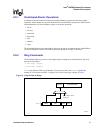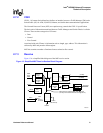
60 Hardware Reference Manual
Intel
®
IXP2800 Network Processor
Technical Description
An alternate system configuration is shown in the block diagram in Figure 11. In this case, a single
IXP2800 Network Processor is used for both Ingress and Egress. The bit rate supported would be
less than in Figure 10. A hypothetical Bus Converter chip, external to the IXP2800 Network
Processor is used. The block diagram in Figure 11 is only an illustrative example.
2.7.1 SPI-4
SPI-4 is an interface for packet and cell transfer between a physical layer (PHY) device and a link
layer device (the IXP2800 Network Processor), for aggregate bandwidths of OC-192 ATM and
Packet over SONET/SDH (POS), as well as 10 Gb/s Ethernet applications.
The Optical Internetworking Forum (OIF), www.oiforum.com, controls the SPI-4 Implementation
Agreement document.
SPI-4 protocol transfers data in variable length bursts. Associated with each burst is information
such as Port number (for a multi-port device such as a 10 x 1 GbE), SOP, and EOP. This
information is collected by the MSF and passed to the Microengines.
Figure 11. Full-Duplex Block Diagram
A9357-02
Intel
®
IXP2800
Network Processor
Framing/MAC
Device
(PHY)
UTOPIA-3
or IXBUS
Protocol
Receive and transmit protocol
is SPI-4 and CSIX on transfer-
by-transfer basis.
TDATRDAT
Bus Converter
Rx
Tx
Tx
Rx
Switch
Fabric
CSIX
Protocol
Notes:
The Bus Converter chip receives and transmits both SPI-4 and CSIX protocols from/to Intel
IXP2800 Network Processor. It steers the data, based on protocol, to either PHY device or
Switch Fabric. PHY interface can be UTOPIA-3, IXBUS, or any other required protocol.


















